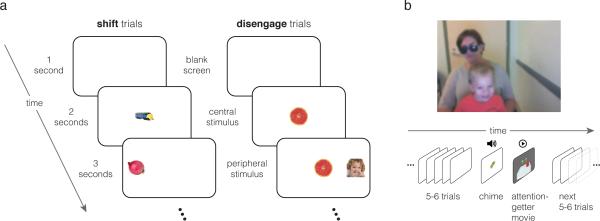Figure 1.
Experimental design. Panel a shows the event sequence within one example trial of each type. Each trial began with a blank screen, followed by the presentation of an image in the center of the screen. After 2 seconds, another image appeared in the periphery, which remained onscreen for 3 seconds, until the end of the trial. In shift trials, the central stimulus disappeared at the moment the peripheral stimulus appeared. In disengage trials, the central stimulus remained onscreen, requiring participants to disengage attention from the central image before shifting their eyes to the peripheral image. b) Toddlers viewed the stimuli while sitting on their caregiver's lap. Every 5-6 trials, an attention-getter played to maintain the toddler's focus on the screen. During the attention-getter, an image appeared in the center of the screen for two seconds as in a standard trial, followed by a chime sound to draw the toddler's interest to the screen if he or she had been looking away. The toddler then saw a six-second video clip of moving, colorful objects (such as billiard balls bouncing on a table). After the clip finished, the experiment continued with the presentation of shift and disengage trials.

